|
Fly fishing and fly
tying books are a passion. Here you will find book reviews of books I have
read covering fly fishing for trout, smallmouth bass, muskellunge,
steelhead, and many other freshwater and saltwater species. You will also
find fly tying books covering the same areas. There are also books on
aquatic entomology, history of fly fishing and fly tying, hydrology, and
great prose having fly fishing as its main theme. There is far more to fly
fishing than casting a line, and there should be far more to a fly fishing
guide service web site than just costs and services offered.

Poul
Jorgensen’s Favorite Flies
by Poul Jorgensen61tackpole Books
Mechanicsburg, PA, 2002
158 pages, hardbound
illustrated, color
suggested price $40.00
reviewed by Bruce E. Harang
This is one of the
better fly tying instructional books on the market. As has become his
hallmark, this book is pleasant to read and easy to understand. Poul is one
of the world’s preeminent fly tiers. Fortunately, for the rest of us, he is
also one of the world’s preeminent fly tying instructors. Once again in this
book both talents show through. And equally important the publishers have
done a first class job of printing and editing allowing for easy use by the
reader.
The book opens with short chapters on “Insects and Their
Importance in Fly Fishing”, and “Materials”. After this short two chapter
introduction the tying instruction starts. The third chapter is directed to
Mayfly nymphs. It includes a short description of types of mayfly nymphs, a
step-by-step instructional section teaching tying Mayfly nymphs and then a
selection of Mayfly nymph patterns important to the fly fisher. The same
format is then used in chapters on Mayfly Duns & Spinners, Caddisflies,
Stonefly nymphs, Hellgrammite Larvae & Crustaceans, Terrestrial Insects,
Coastal Flies, and Northern Pike Flies.
As Poul does in his live classes his book again stresses the
need to learn your materials and tying techniques until they are second
nature. The need to learn to work with materials and their strengths instead
of trying to force a material to do a job it can not. In addition, Poul
gives some interesting ideas and instruction on using alternative materials
for old standards and new synthetic materials to allow for the creation of
effective flies that were not possible with older materials.
If you have not taken instruction from Poul through one of his
many fly tying instructional books in the past you need to learn from this
one. It is easy to read, easy to understand and the author’s enthusiasm will
make you want to head directly to the vise. The hints, tips, techniques and
tricks Poul shares in this book make it a must have volume for any fly tier
wanting to master his craft.
Now please excuse me as I just have to tie a few of these
Hammerhead Frog pike flies.
©
2003 Bruce E. Harang
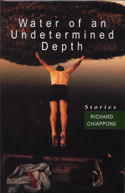
Water of an
Undetermined Depth
by Richard Chiappone
Stackpole Books
Mechanicsburg, PA, 2002
131 pages, hardbound
not illustrated
suggested price $19.95
reviewed by
Bruce E. Harang
The author won the 2002
Robert Traver Award for Fiction. After reading this book it is clear he
desired the accolade. Richard has an unbelievably wonderful ability to
develop characters using the written word. This book of fourteen short
stories will keep you on the edge of your emotional seat and turning pages
feverishly until you suddenly realize there are no more pages, you have
reached the end of the book. And when you get there you want to rush to the
bookstore and try to find more by the author.
Not really a book about fly fishing but instead a book about
people, some of whom fly fish or guide fly fishers and always about water.
From a former Los Vegas stripper playing poker in an Alaska fish camp to a
bird watching son in Ascension Bay cuckolded by his overbearing father, the
characters are the essence and the thrill of the book.
This is really a great read. Purchase the book, read it and you
too will be hounding books shops for more. Absolutely outstanding writing by
a stunningly refreshing new outdoor writer.
©
2003 Bruce E. Harang
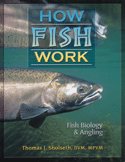
How Fish
Work
by Thomas J. Sholseth, DVM, MPVM
Frank Amato Publications, Inc.
Portland, OR, 2002
86 pages, softbound
illustrated, color
suggested price $19.95
reviewed by
Bruce E. Harang
Did you ever want to
know why the red & white daredevil spoon worked so well on so many different
kinds of fish? How about knowing why peacock herl is such an effective
material for triggering fish to strike a fly? Would you like to know the
correct method of reviving a fish so that once he swims away he has the
greatest chance of survival?
Well, this new book, by a man really does know, is the place to
find these and many more answers that will allow you to catch fish more
effectively.
The author takes modern science and turns it into language every
fly fisherman can understand. More importantly he turns it into information
every fly fisherman can use in his everyday fishing. In addition, the
information provides a sound practical scientific basis for fly design for
all types of fish. In short this is really good stuff that is easy to read
and use.
The book is broken down into chapters on the angling
environment, the aquatic environment, fish hardware (the hardwired stuff in
a fish), light, sensing, behavior, fishing heresy, predator/prey
relationship, strike response, and how to create and use a field guide. The
final chapter is directed to how to correctly provide fish CPR and how to
collect a sample scale for your records. Each chapter is short and succinct.
At the same time each chapter presents a key bit of scientific information
important to the fly fisherman and fly tier in everyday language. You are
never overwhelmed by too much of a good thing and the author doesn’t bore
you with how smart he is.
Even if you don’t want to keep journals or collect and analyze
data about your fly fishing this book will allow you to be a much more
successful casual fly fisherman. And if you want to design or redesign fly
patterns that have an improved ability to trigger fish to strike this book
will be a true eye opener.
Buy this book, read it, use the information and be a happier fly
tier and fly fisherman. A great value and a great read.
Oh yes, the daredevil works because of contrast, the herl is a
polarized light reflector, and you definitely don’t want to use the CPR
method on a Musky.
©
2003 Bruce E. Harang
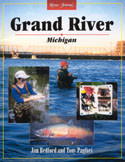
Grand River, Michigan –
River Journal
by Jim Bedford & Tony Pagliei
Frank Amato Publications, Inc.
Portland, OR, 2002
47 pages, softbound
illustrated, color
suggested price $15.95
reviewed by
Bruce E. Harang
The Grand River in
Michigan and its tributaries drain a major portion of the southwest Lower
Peninsula before entering Lake Michigan. The river is home to smallmouth
bass, brown trout, rainbow trout, walleye, northern pike, and carp, as well
as hosting runs of Coho salmon, Chinook salmon, Lake trout, lake run brown
trout and steelhead.
With all of these species to target and miles of river to fish
the new comer can be completely overwhelmed. This book will change this. You
are given a basic layout of all of the water suitable for fishing. Included
are locations to access the various waters and where to start fishing. Flies
and gear to use for particular species and at particular times of the year
are also described. Also included are basic maps of the waters as well as
great photos of the various fish and fishing locations. The book finishes
with a list of fly and tackle shops in the area as well as a list of local
Chambers of Commerce for help with gear, lodging, etc.
You will not be a Grand River expert by reading this book, but
you will have greatly improved your chances of having some fishing success.
You will be in a position to find some nice fish and have a very pleasant
trip to this fine river system.
The layout is well done. The writing is easy to read and very
easy to understand. This small volume is a great way to introduce yourself
to this fine fishery.
©
2003 Bruce E. Harang

Trout Country Flies
by Bruce Staples
Frank Amato Publications, Inc.
Portland, OR, 2002
167 pages, softbound
illustrated, color
suggested price $29.95
reviewed by
Bruce E. Harang
The Yellowstone area of
the western US is a world famous fly fishing destination. It holds legendary
rivers such as the Big Horn, Gallatin, Henry’s Fork, Madison, and Missouri.
It has also attracted some of the best and brightest fly tying personalities
of the twentieth century. Bruce Staples has written a book that goes a long
way toward preserving this fly tying heritage.
The book opens with a short historical introduction and then
proceeds to display and describe fly patterns created, modified, or
transported to the Yellowstone area in seventeen chapters broken down by fly
pattern style. The photographs of the flies are extremely well done by Jim
Schollmeyer. The author presents the recipe below each image. However, the
most important and useful information are the historical notes also provided
each fly. The images of the rivers and streams of the area as well as of the
personalities that have formed the history of fly tying and fly fishing in
the Yellowstone area make the book even more interesting and historically
significant. The chapters on fly patterns are followed by a short chapter on
the legendary fly tiers of the area. And the book concludes with a
bibliography, fly pattern index, and general index. These last sections make
the book a wonderful resource because of the well done indexing of the books
information.
If you wish to learn about the fly patterns, fly tiers, and
history of fly tying in the Yellowstone area this book is a great starting
point. It is well done and easy to read. A book every fly tier should have
on his tying bench.
©
2003 Bruce E. Harang
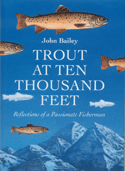
Trout at Ten Thousand Feet
by John Bailey
Stackpole Books
Mechanicsburg, PA, 2001
175pages, hardbound
illustrated, Black&White
suggested price $19.95
reviewed by
Bruce E. Harang
This book has a subtitle
of “Reflections of a Passionate Fisherman” and the author is clearly that, a
passionate fisherman. As you read the tales and yarns in the book you will
realize John Bailey is more than passionate, he is consumed by fishing. And
his book reflects his passion with great clarity and insight.
The book is about a passion for fishing but it is not about
fishing as written by most modern authors. There is no I caught this fish
with this gear at this spot with this fly or bait. Instead you are pulled
into his passion thorough his tales of the journeys to the fish more than by
the fishing. The reader is sucked down into a vortex of sensory images of
tigers in tall grass, derelict helicopters, crime bosses, poachers, and
interesting characters traveled with over most of the globe.
This book is a most interesting and refreshing collection of
short stories about fishing. And most importantly, this book reminds us all
that it is the journey not the destination that makes up living. In reading these
stories every fisherman will node and smile and remember his personal
lifetime of journeys to fish. And what better thoughts can any book evoke in
a reader?
Fantastic read, well written and edited. No one who fishes
should be without this book.
©
2003 Bruce E. Harang
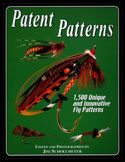
Patent
Patterns
by Jim Schollmeyer
Frank Amato Publications, Inc.
Portland, OR, 2002
195 pages, hardbound & softbound
illustrated, color
suggested price $39.95 & $29.95
reviewed by
Bruce E. Harang
Jim Schollmeyer has
edited a very interesting fly pattern book. There are fifteen hundred
patterns and images of the flies submitted by the tiers who sent them in to
the “Fly Fishing and Tying Journal” for the magazine’s Patent Patterns
contest. The editor has photographed each one of the submitted flies. And
has presented each of them with the recipe and where appropriate, additional
notes. What makes this book so interesting is that most of the patterns are
adaptations of standard patterns, or new patterns, by fly fishermen all over
the world to solve their own specific problems on their own waters. What
this has done is provide the fly tier with a series of unique perspectives
into solving the age old fly fishing problem of, “what fly should I use”.
You will find beautiful flies, ugly flies, neat and tidy flies,
as well as rumbled and bedraggled looking flies. But each and everyone
presents the reader with an insight into different ways to solve the problem
of representing a live food item in an artificial fly. Here you can find a
wonderful collection of ideas on how to utilize color, form, and texture to
represent or imitate food items, or simply to aggravate a fish into
striking. You will also be presented with a huge tool box of fly tying
materials from which to shape your own fly tying palette. Materials that
range from the common place to the absolutely “out in left field”. But every
one of them presents an opportunity for the fly tier to tie better flies.
The book is organized into thirteen chapters with each chapter
directed to a single type of fly. Mayflies, Caddisflies, Stoneflies, and
Midges of course, but also Attractor Patterns, Soft Hackles and Wet Flies,
Damselflies and Dragonflies, Terrestrials, Streamers, Scud and related bugs
as well. And, to include most of the fly fishing opportunities there are
also chapters on Bass and Bluegill flies, Atlantic Salmon, Steelhead and Sea
Trout flies, and Inshore Saltwater Flies. The book finishes with a very good
fly pattern index and fly tyer index. The photographs are all very good to
excellent and the editing is superb. There are at least three images that do
not match the recipe associated with them, and most interestingly also don’t
match any other recipe in the book either. Otherwise the book is truly well
edited. The printing and layout are also exceptionally well done. A first
rate book that will help inspire every fly tier no matter his level of
expertise.
This is a fly tying inspiration book that needs to be on every
fly tier’s tying bench.
©
2003 Bruce E. Harang

Hot Bass
Flies
by Deke Meyer
Frank Amato Publications, Inc.
Portland, OR, 2003
134 pages, softbound
illustrated, color
suggested price $24.95
reviewed by
Bruce E. Harang
A fly pattern book that
is fun to read, Deke Meyer has produced a bass fly pattern book that is both
informative and fun. Not an easy thing to do with a book containing recipes
for fly patterns. But the mix of patterns, extended notes on tying and
fishing many of the patterns as well as stories by the pattern creators
makes this a most enjoyable read as well as an excellent reference. The
excellent writing is accompanied by the excellent photographic work of Jim
Schollmeyer who provides top quality images of every one of the book’s
patterns. The additional photographs of folks having fun fishing for bass
complete the fun aspect of this well designed book. The author writes with a
clarity seldom found in the outdoor writing arena anymore. The editing and
printing of this book once again showcases the dedication and
professionalism of the Frank Amato Publications group. These folks are
producing some of the finest illustrated fly fishing books today, and this
book is a prime example.
The book is broken down into seven chapters, each dealing with a
type of bass fly. There are sections on poppers, sliders, floating divers,
floating critters, fly-rod spinnerbaits, crayfish and subsurface flies. Each
section has a clear easy to read short introduction and then the reader is
taken directly to some of the finest bass fly patterns available to the fly
fisherman. You will find flies by the legends of bass fly fishing like Tom
Nixon’s Calcasieu Pigboat, and the poppers of E. H. “Peck” Peckinpaugh. You
will also find the patterns of the modern masters such as the Dancing Frog
of Jim Stewart, the Floating Minnow of Andy Burk, and the Mega Slop Slider
of Larry Dahlberg. Finally, the reader will find dozens and dozens of
effective bass flies of all types by known and unknown bass fly fishermen
who have spent the time and paid the dues to develop extremely effective
flies that catch bass all over the world.
The final chapter is about fly fishing for the native bass of
Australia. And like most everything else in Australia these fish are tough
and strange. This is story is a really interesting ending for any book on
bass fly-fishing and a real surprise in a pattern book.
There are a number of good books in print and out of print on
fly fishing for bass. There are even a few bass fly pattern books. But this
book has clearly raised the standard for bass fly books several notches.
If you tie flies for bass or are interested in patterns that are
proven to catch bass, this book is definitely a must have. Good information
presented in an easy and fun to read manner. You can’t do any better than
this book for bass fly patterns.
©
2003 Bruce E. Harang

Trout Stream Fly-Fishing
by Harry Murray
Frank Amato Publications, Inc.
Portland, OR, 2003
103 pages, softbound
illustrated, color
suggested price $9.95
reviewed by
Bruce E. Harang
This is a book small in
size but big in its being able to get a fly fishing beginner catching fish.
Physically the book is 4 by 6 inches so that the beginner can take his text
book with him on stream. It is also very inexpensive to purchase so there is
no need to fear getting it wet or losing it. That is where smallness stops
however. Within this small framework the author has assembled a tremendously
large and excellent body of fly fishing know-how to get the beginner up,
out, and catching trout.
The book is directed to teaching a beginner how to fish small
and medium sized trout streams. In order to make sense of this the author
first clearly defines the types of trout water he is going to talk about and
then discusses the trout he is going to teach the reader to catch. The book
then moves to general topic chapters on fly tackle, fly casting, trout
foods, reading water, and spotting trout. Along the way Harry provides the
reader with some clear insights to fly fishing truths that don’t seem to be
taught anymore. For example the author reminds us all of the simple fact
that “…fly size governs the line size and the line size governs the rod
weight.” And the clear logic of Charlie Brooks in teaching that presentation
is everything and the fly fisherman’s job is to find that one spot in the
stream that allows for the best presentation of the fly to the trout.
Casting is covered in two and one half pages of text and two illustrations.
The few knots needed to start fly fishing successfully are clearly described
and illustrated. The basic gear and its relevance are also well described in
just a couple of pages. In other words, the beginner is given what is needed
without the catalog of bells and whistles that only confuses.
The final three chapters teach specific strategies for fishing
in the early season, the late spring/summer season, and the fall season.
With detailed text and great color illustrations showing excellent methods
of dry fly, nymph, and streamer fishing for each of these times of the trout
fishing year.
The production in full color and the excellent layout is simply
amazing for a book which will cost you less than ten dollars.
If you or someone you know wants to learn to successfully fly
fish for trout this little jewel will do the job. This book presents a well
defined goal and then provides a clear concise plan that allows for reaching
that goal. It will get the beginner started, be a good companion, and allow
the beginner to succeed in catching some trout. That is its purpose and it
does that well. For the beginner, this book is worth far more than its cost.
©
2003 Bruce E. Harang

Fly-Fishing Western Trout
Streams
by Jim McLennan
Stackpole Books
Mechanicsburg, PA, 2003
207pages, softbound
illustrated, Black&White
suggested price $16.95
reviewed by
Bruce E. Harang
Jim McLennan provides
the beginner and the visiting fly fisherman with a complete course in
fishing the rivers and streams of the western portion of North America. From
the Rockies to the Pacific Ocean the streams and rivers are in many ways
very different from those of the eastern portion of the Continent. Different
in some of the fish they may hold, different in the timing of hatches, and
different in how they receive their water in many cases. Likewise the
geology of the area provides different water chemistry and different
climates than found in most other parts of North America. The author
explains these differences so that the fly fisherman has the basic knowledge
of the fisheries available. This information is presented in the first two
chapters of the book in a clear though somewhat tedious fashion.
The rest of the book provides the solutions and the tools to
successfully fish the west. It is pleasantly easy to read and the author’s
wonderful sense of humor is allowed to shine through making the nine
remaining chapters of the book a really fun read as well as informative one.
The major tools and techniques are broken down, analyzed in light of western
streams and their unique characteristics. You will have a good handle on
equipment, presentation, watercraft, trout food, trout seasons, hatches, and
favorite fly patterns. In addition, you are presented with the tools
specific to wading as well as those specific to floating to fly fish for the
trout of the west.
The editing is excellent; the writing style, after the first two
chapters, is a joy to read. The author’s writing is clear, concise, and
humorous. How can you not like a fly fishing writer that lists a cell phone
on the river as “not a chance”. And the instruction is straight forward and
well presented. The four color plates present two pages of the favorite
flies for the west extremely well tied by Glen Smith and beautifully
photographed by Michael Radencich. The other two pages of color plates,
photographed by the author, present the reader with images that fly fishing
dreams are made of. Not a bad combination.
If you are planning on learning to fly fish in the west or are
planning on visiting the west to fly fish, this book is a must have.
©
2003 Bruce E. Harang
|










